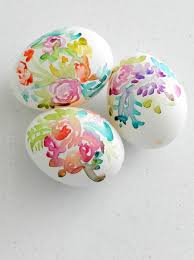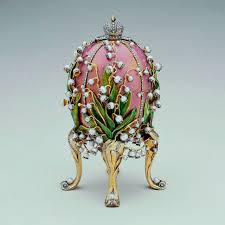The story of Easter eggs and Fabergé
Eggs have long been associated with the Christian festival of Easter which celebrates the resurrection of Christ. The custom of giving Easter eggs relates back to ancient pagan practices linked to Spring rites. The egg has long been a symbol of fertility, rebirth and the beginning. The egg as a symbol of life came to represent the resurrection.
Eggs as an Easter gift
The earliest eggs were hen or duck eggs decorated in bright colours using vegetable dyes and charcoal. This practice continues and eggs are often decorated with flowers. In Eastern European countries wooden eggs are also decorated and beautifully patterned – the patterns often have particular meanings and help to tell the Easter story.

In the 17th and 18th century egg shaped toys were manufactured, often in cardboard, plush or satin covered, filled with Easter gifts and chocolates.
Chocolate eggs were first made in Europe in the early 19th century. France and Germany took the lead in creating artistic confectionery. Earlier eggs were solid until the arrival of mass production of hollow, pressed eggs.
The first chocolate eggs in the UK made by well-known manufacturers had a smooth surface in dark chocolate and were filled with sugared almonds. These were made as a whole shell. The earliest decorated eggs were plain shells with piped chocolate and marzipan flowers. During the 1800’s decorative skills blossomed with many designs being based on ornate French, Dutch and German influences – these were pared down for Victorian tastes.

Milk chocolate was first launched in the early 1900’s and this saw the market flourish, improving sales vastly. Easter eggs are now made using two half shells.
Fabergé eggs
During the early 20th century Czar Alexander 111 and Czar Nicolas 11 had some special Easter eggs commissioned from the jeweller Carl Fabergé.
The first egg was a gift from Alexander 111 to his wife, made of gold and white enamel. It was known as the Jewelled Hen’s Egg. Inside the egg was a golden yolk containing a golden hen with ruby eyes. Inside the hen was a tiny golden crown. The Czar loved the beauty of the egg and asked Fabergé to make a special egg for his wife every Easter. Fabergé was given freedom of design with the stipulation that each egg should contain a surprise. Fabergé also made eggs for other members of the Russian royal family and as presents to other monarchs. His eggs are very precious and are kept in museums and royal collections.
The House of Fabergé made 50 such "Imperial" Easter eggs and it is thought that 43 of these survive.





